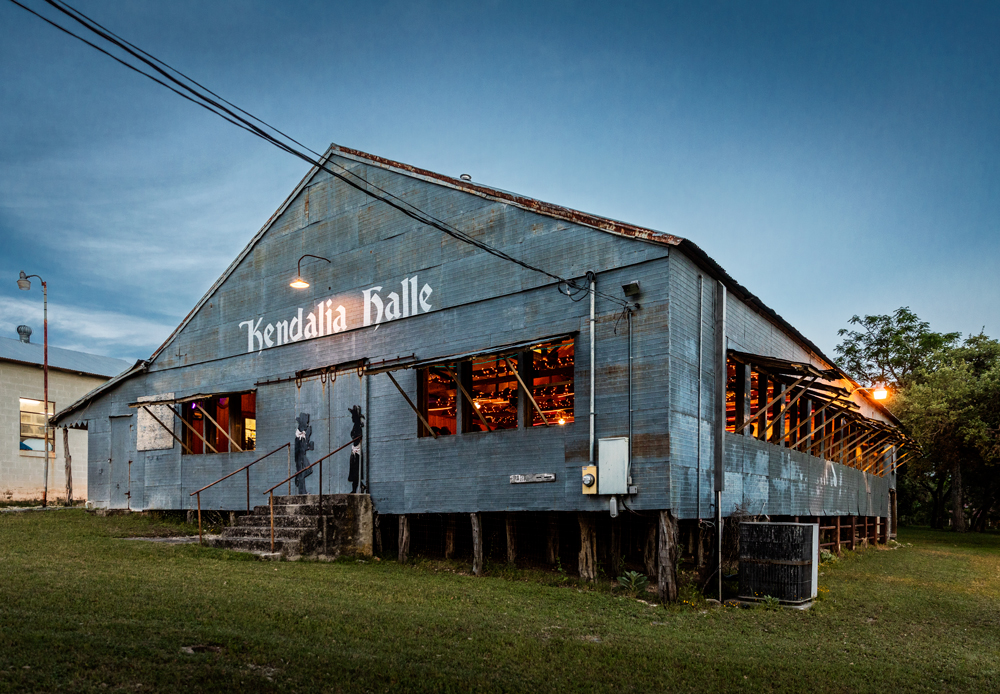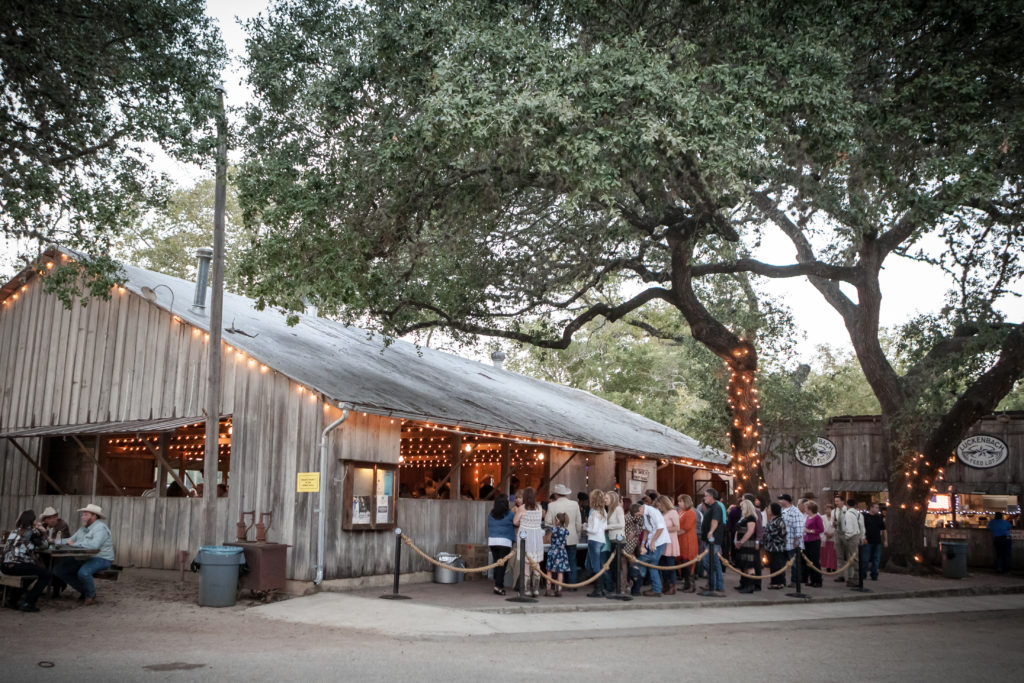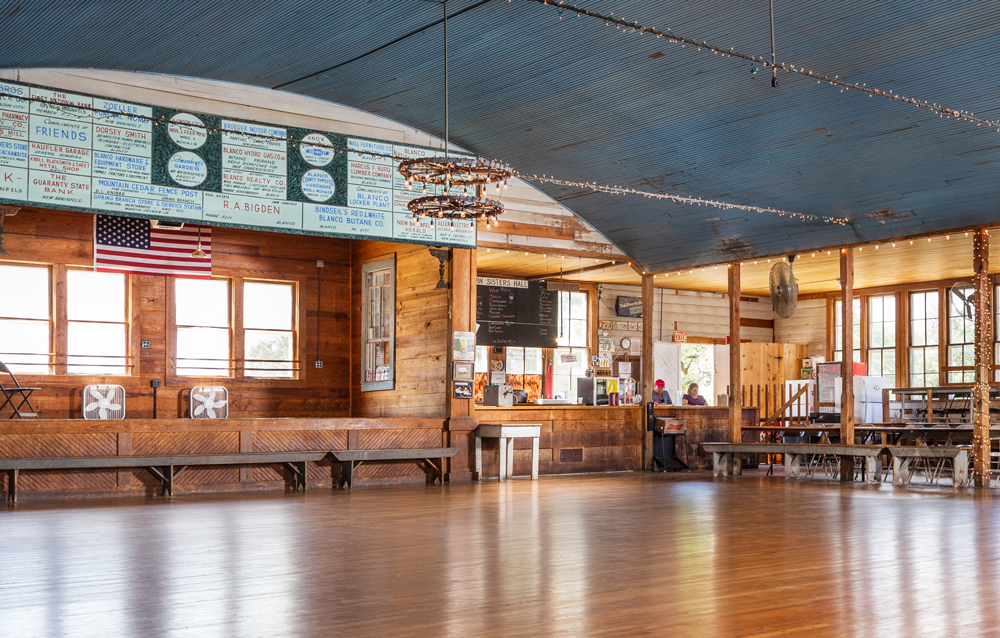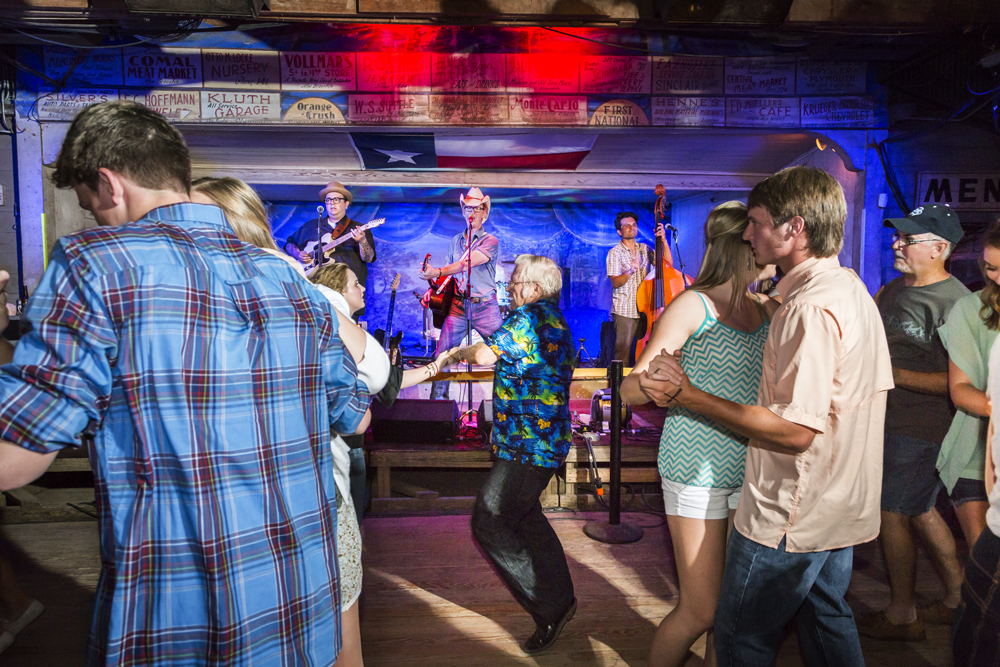Historic Dance Halls of Texas
My dance partner and I were traveling down a two-lane asphalt road through the middle of the Texas Hill Country. It was pitch-black outside. Off the side of the road, my headlights caught the eyes of a herd of cattle pressed up against a wire fence. We were about 65 miles west of Austin, 45 miles north of San Antonio. For all intents and purposes, it was the middle of nowhere. But we had no doubt in our minds that what lay down the road was one of the best nightlife spots in all of Texas: Kendalia Halle, one of the state’s last remaining historic dance halls.

Kendalia Halle, one of the last historic dance halls of Texas, sustains a living history in its out-of-the-way corner of the Hill Country. Photo by Jeff Wilson.
Kendalia Halle, Kendalia
Kendalia Halle is not much more than a long, single-story clapboard building on an exposed pier-and-beam foundation, tucked under post oaks and elms in a quiet, out-of-the-way corner of the Hill Country in the tiny unincorporated community of around 450 in Kendall County. When we arrived, the hinged shutters around the wooden building were thrown open. The metallic twang of Fender Telecasters and the lonely whine of a pedal steel guitar danced out across the surrounding pastures. Inside, couples of all ages two-stepped in a steady circle around the well-worn floor, while men in cowboy hats and boots leaned up against the bar.
As the hour pushed midnight and the band careened through song after song, it was impossible to shake the feeling that there was something transportive — almost magical — about joining the couples in the swirl underneath the twinkle of fairy lights, knowing that couples, lovers, children, and grandparents have been shuffling across those very floorboards nearly every month since the hall first opened in 1903.
The legacy of Texas’ dance halls dates back to the very founding of the state. In the 19th century, when German and Czech immigrants came to Texas, they built churches, schools, and public meeting halls that often doubled as town halls, community banquet halls, and entertainment centers. These halls became the linchpin of rural social life.
Over time, polka and traditional dances blended with the rest of Texas’ rich cultural melting pot, and the dance halls became incubators of Texas country, western swing, Tejano, and conjunto. Today, these halls continue to sustain a living history.
Anhalt Hall, Spring Branch
The Germans who settled along the Guadalupe River started communal organizations to help farmers and rural business owners. One of those organizations, the Germania Farmer Verein, established Anhalt Hall in Spring Branch in 1875. Today, the hall hosts regular dances and is a popular rental facility for weddings.
Swiss Alp Dance Hall, Swiss Alp
The German roots of this Fayette County classic are written into its name. Since it opened in 1900, the venue has hosted generations of Texas legends — from Bob Wills to Johnny Winter to Asleep at the Wheel. Today it remains a popular concert spot and wedding reception hall.
Tom Sefcik Hall, Seaton
Located just east of Temple, Seaton is home to a population of only 60. But Tom Sefcik Hall hosts regular karaoke nights, as well as Czech and Texas music concerts on the original 1923 oak floor.

Photo by Michael Clouser.
Luckenbach Texas, Luckenbach
The unincorporated community of Luckenbach consists of two main buildings, one housing an old post office that operated until 1971 as well as a saloon and general store reportedly opened in 1886, and the other, the dance hall. First established as a community trading post in the 1840s (locals boast that it was one of the few that never broke a peace treaty with the Comanche Indians), the town was eventually abandoned and sold in 1970. The buyer used the town’s rights as a municipality to govern the dance hall.
There used to be dance halls like this all over Texas, according to Steph McDougal, co-founder of Texas Dance Hall Preservation Inc. As Europeans from Germany and countries like Moravia and Silesia — now the Czech Republic — came and settled across Texas through chain migration, these halls became the focal points of settlements and towns.
Albert Dance Hall, Albert
The German settlement of Martinsburg was renamed after Albert and Minnie Luckenbach sold their store and settled there in the late 19th century. By the 1920s, the Albert Dance Hall and the dance hall in Luckenbach were also sharing German brass bands, which played at regular dances. Sadly, the town of Albert fell on hard times and the dance hall was closed until it was eventually purchased in 2009 and reopened, hosting music every weekend.
Sons of Hermann Hall, Dallas
Built in 1911 after the four Sons of Hermann societies in Dallas merged, the hall maintains an old-world neighborhood vibe. It hosts fraternal organization meetings and legendary musicians alike; the latter over the years have included names like Townes Van Zandt, Wilco, Arlo Guthrie, and Junior Brown.
Schroeder Hall, Goliad
The second-oldest dance hall in Texas once also served as a shoe store, grocery, and saloon. In 1986, it still sold groceries, gasoline, and hardware. The original 1890 hall was reconstructed in 1935, and today it continues to host a steady stream of Texas musicians.
John T. Floore’s Country Store, Helotes
John T. Floore wasn’t looking to make history when he added a stage for live performances to his store in the 1950s — just an extra buck. But the venue outside of San Antonio has become famous for becoming Willie Nelson’s “musical birthplace.”

Photo by Jeff Wilson.
Twin Sisters Hall, Blanco
Twin Sisters, a dance hall and community center built by German immigrants in 1879, is operated by a volunteer board, the Twin Sisters Hall Club, that is collecting historical documentation of the hall and its uses over time. The public dances remain open, and the hall and grounds can be rented for weddings and other events.
Dance-hall culture did not grow spontaneously out of new settlements. European settlers brought with them a rich tradition of organizing clubs and formal social groups. “You have a lot of organizations for singing societies and athletic societies and farm societies,” McDougal says. “And those organizations are the ones that built the hall.”
In many instances, those very societies — including many Czech fraternal organizations and the German Sons of Hermann — continue to own and operate Texas’ dance halls.
“A big part of what you see here in Texas is this very strong community-oriented, club-oriented culture that was very music-based,” McDougal says. “In rural areas, dancing was one of the activities you had to meet other young people in those days, and to take the kids out. People would ride horses all day and all night to get to a dance.”
London Dance Hall, London
The tiny town of London is off the beaten track, even for Texas. But that hasn’t stopped the family-owned dance hall from offering live music every Saturday night.
The Old Coupland Inn & Dance Hall, Coupland
Although the building dates to 1904, the dance hall in Coupland isn’t that old. Over the years, the building served as a hardware store, grocery, and drugstore. In 1992, new owners converted it into a beloved dance hall, music venue, and restaurant just a skip from Austin.
Broken Spoke, Austin
Austin’s beloved dance hall almost met with the wrecking ball as development in the booming capital encircled it. But the old honky-tonk survived and still serves up comfort food, dance lessons, and regular concerts and dances.

Some of the biggest country musicians in the world made their start playing at Gruene Hall. Photo by Jeff Wilson.
Gruene Hall, New Braunfels
Gruene Hall, Texas’ oldest and best-known dance hall, stands 6,000 square feet with a pitched tin roof. Built in 1878, it’s become an internationally recognized tourist attraction and draws big talent. George Strait, Lyle Lovett, Garth Brooks, the Dixie Chicks, and Willie Nelson have all played Gruene Hall, a rite of passage for Texas country stars.
With the advent of radio in the early 20th century, some dance halls began hosting live radio broadcasts, and the music played began to spread far beyond Texas’ rural communities, helping to build a distinctive identity around dance-hall culture. New halls were constructed, and the venues became places where the Old World greeted the new. In the early 1950s, listeners could tune into KTAE to hear performers like Slim Whitman, Kitty Wells, Little Jimmy Dickens, and Jim Reeves, at the same hall where the Vrazel brothers honed their brand of Tex-Czech polka, broadcast on KMIL beginning in 1957.
But the halls that stand today still encapsulate that old Texas frontier aspect. They’re where communities gather, they’re where music happens, and they’re where people go to dance.
Looking to see more of Texas? Check out our travel guides here.
© 2018 Texas Farm Bureau Insurance



